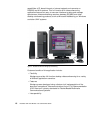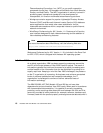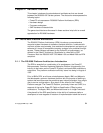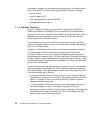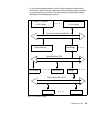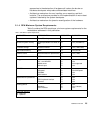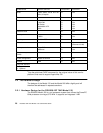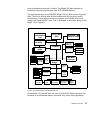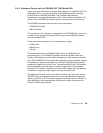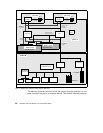24 RS/6000 43P 7043 Models 150 and 260 Handbook
2.1.3 RS/6000 Platform Architecture Achievements
The RS/6000 Platform Architecture specification achieves the following:
• Creates a stable platform architecture to be used by all RS/6000 platforms
based on PowerPC processors and PCI I/O bus (and may contain other
I/O buses in addition to the PCI bus).
• Creates an architecture that allows platforms to operate with a previous
version of AIX (n-1 capability).
• Leverages existing and future industry-standard buses and interfaces.
Existing bus architectures have a proven level of performance and
function. Established industry-standard interfaces (for example, SCSI,
IDE, LocalTalk, Ethernet) and newer bus architectures, interfaces, and
protocols (PCI, PC Card, IrDA, to name a few) provide higher levels of
performance or utility that are not achievable by the older standards. The
architecture allows platform and system designers to determine which
buses, interfaces, and protocols best suit their target environment.
• Provides a flexible address map. Another key attribute of this specification
is the relocatability of devices and subsystems within the PowerPC
address space. Subsystem address information, which defines where I/O
devices reside, is detected by the Open Firmware and passed to the
operating systems in the device tree. The architecture accommodates the
use of multiple identical buses and adapters in the same platform without
address conflicts.
• Builds upon the Open Firmware boot environment defined in IEEE 1275,
IEEE Standards for Boot (Initialization Configuration) Firmware, Core Requirements and
Practices, IEEE part number DS02683, ISBN 1-55937-426-8. (To order
copies of IEEE standards, load the following Web site:
http://standards.ieee.org/index.html).
In the past, the abstraction approach for the operating system used
platform description information discovered by a legacy boot process and
passed it to the operating system in data structures.
• Architects the control of power management by the operating system. It is
important that the combination of hardware and software be allowed to
minimize power consumption through automatic or programmed
power-saving methods. Power management of systems will reduce the
operational cost for the user and reduce the impact of the system on the
environment.
• Provides an architecture that can evolve as technology changes.
• Minimizes the support cost for multiple AIX versions through the definition
of common platform abstraction techniques. Common and compatible



